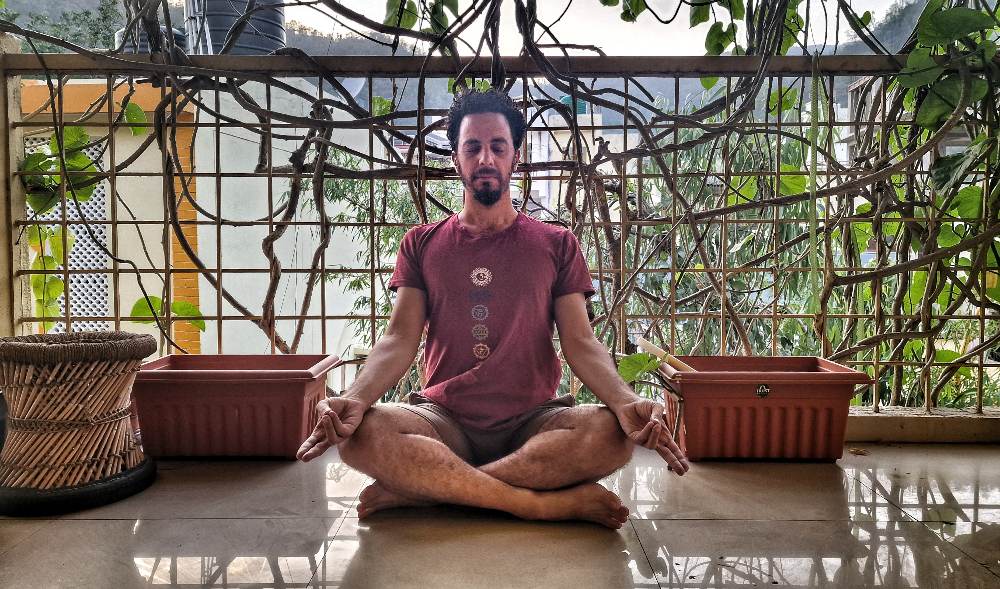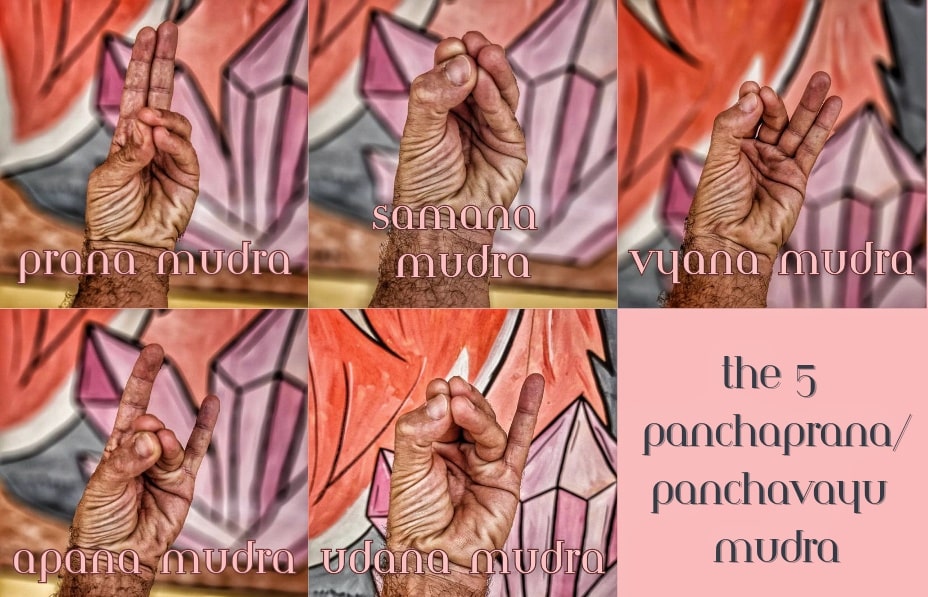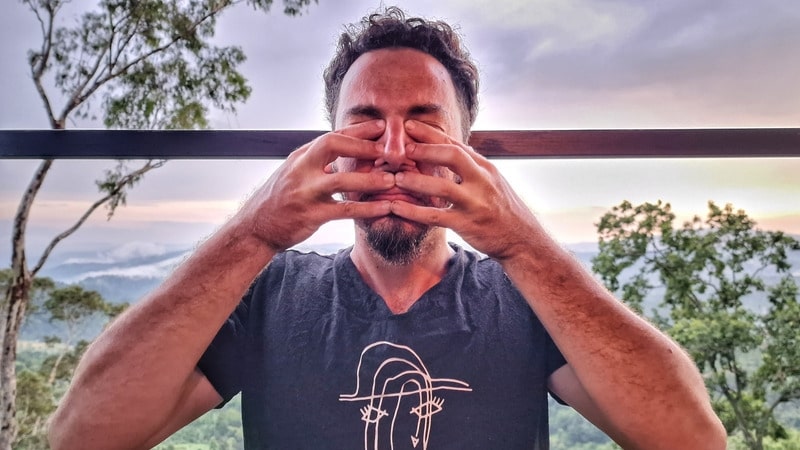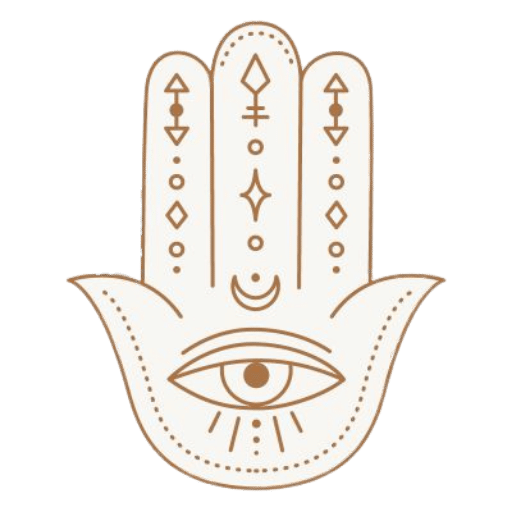
Prana Kriya, a traditional Kundalini Tantra Yoga practice for balancing the Vayus: Prana, Apana, Samana, Udana, Vyana
Completed with Panchaprana / Panchavayu mudras and mantras
Prana Kriya is a powerful kundalini practice accessible to everyone. A mediation to balance the vayu system, the five pranas giving life to our body.
I learned this kriya in Rishikesh, it’s an ancient traditional kundalini tantra practice orally transmitted from guru to disciple for centuries.
There are no contraindications to this kriya, no annoying side effects, and no risks related. It’s a fundamental practice that is recommended for beginners.
Practicing Prana Kriya every day for one month or more is sure to balance your panchavayus (sometimes called panchaprana), bringing an overall balance to your mental and physical health.
Check Also
> Exploring Antar Kumbhaka: The Inner Breath Retention
> Bhastrika Pranayama: Benefits, Steps, and Precautions Of Bellow Breathing
> Kashtha Takshanasana: How To & Benefits of the Wood Chopping Pose + A 15 Min Kundalini Kriya

The Panchavayu/Panchaprana System
The Panchavayu system is a fundamental concept in yogic anatomy and Ayurveda, it describes the five types of prana, the five energies or vital winds of the body governing different physiological functions and activities.
These pranas are called Vayu, and are of 5 types: prana vayu, apana vayu, samana vayu, udana vayu, and vyana vayu.
The Vayus circulate throughout the body and are responsible for the movement and function of different bodily systems, they play a crucial role in maintaining overall health and well-being.
- Prana Vayu: responsible for the respiratory and circulatory systems, it keeps the chest and its organs alive – lungs, hearth, and thymus gland depend on it. It is the life force that enters the body through the breath and sustains all bodily functions. It’s associated with Anahata, the hearth chakra.
- Apana Vayu: responsible for the exhalation of breath and the elimination of waste and toxins from the body. Apana vayu governs the downward and outward movement of energy and is the prana of excretion, in charge of the intestines, bladder, and the whole reproductive system. It is located in the lower abdomen and associated with the root chakra. It is located in the lower abdomen and pelvis.
- Samana Vayu: The Vayu responsible for the digestion and assimilation of food and nutrients in the body. In control of all the upper abdominal organs – liver, spleen, pancreas, kidneys, and adrenal glands. It is located in the area of the navel and associated with Manipura and Swadistana Chakras.
- Udana Vayu: the prana of the five senses and communication. It governs the movement of information within the body (nervous system) and outwards – perceptions, speech, expression, and even higher conscious states. It is located in the head and limbs and relates to Vishuddi chakra.
- Vyana Vayu: This Vayu is responsible for the circulation of blood and other bodily fluids throughout the body. It is located everywhere within our organism.

Elements of this Kundalini Yoga Practice for Balancing the Vayus – Prana, Apana, Samana, Udana, Vyana
1. Bhramari pranayama
Bhramari Pranayama is a powerful breathing technique that is known for its calming and soothing effects on the mind and body. It is also known as “bee breath” because of the humming sound that is created during the practice.
The word “Bhramari” is derived from the Sanskrit word “bhramar”, which means “bee”. In this practice, we mimic the humming sound of a bee to create a vibration in the body and calm the mind.
To practice Bhramari Pranayama, follow these steps:
- Sit comfortably in a quiet place with your back straight and your eyes closed.
- Close your ears using index fingers or thumbs. Cover your eyes with the palms of your hands without applying pressure.
- Take a deep breath in through your nose, hold for a second.
- As you exhale, make a high-pitched humming sound, like that of a bee. Feel the vibration in your body.
- Continue to breathe in and out in this way, focusing on the sound and vibration.
- You can practice Bhramari Pranayama for 5-10 minutes, gradually increasing the duration as you become more comfortable with the practice.
The benefits of Bhramari Pranayama are numerous. It is a great practice for reducing stress and anxiety, improving concentration and focus, and promoting relaxation and sleep. It can also help to regulate blood pressure, reduce headaches and migraines, and alleviate tension in the face and jaw.
In addition, Bhramari Pranayama can be helpful for people with respiratory issues, such as asthma or bronchitis, as it can help to improve lung function and clear the airways.
There are many peer-reviewed studies on the benefits of Bhramari, here’s is one of several examples.
I encourage you to incorporate Bhramari Pranayama into your daily practice. It is a simple yet powerful tool that can help to bring balance and harmony to your life.
2. Shanmukti Mudra
In Sanskrit, “shanmukti” means “six-faced,” and it refers to the six main energy centers, or chakras, that are associated with this mudra.
Shanmukti Mudra enhances concentration by facilitating pratyahara, withdrawal of the senses, the fifth limb of yoga according to Patanjali yoga sutras.
Shanmukti Mudra is practiced with closed eyes. Bring your hands up to your face, with your elbows pointing out to the sides. Place your thumbs over your ear canals, your index fingers over your eyes, your middle fingers over your nostrils, your ring fingers over your upper lips, and your little fingers over your lower lips.
Gently apply pressure with your fingers to create a seal, but do not press too hard. Breathe deeply and evenly through your nose, focusing your attention on your breath and the sensation of the fingers on your face. You can hold this mudra for several minutes, or for as long as it feels comfortable.
Shanmukti Mudra is a powerful tool to activate the parasympathetic nervous system, the rest and digest section of our NS, thus promoting relaxation and helping to reduce stress and anxiety. It is also said to enhance the flow of prana, or life force energy, throughout the body.
This mudra is often associated with the practice of bhramari, as it happens to be the case in this kundalini kriya for the third eye. Nevertheless, both practices are very powerful to be practiced on their own and should be combined only when instructed.
3. Kechari mudra
Kechari mudra is a powerful and advanced yoga technique that involves touching the lower surface of the tongue to the soft palate at the back of the mouth. This mudra activates the higher centers of the brain and promote spiritual growth and awareness.
According to some traditions, kechari mudra holds the secretion of the amrita, the nectar of immortality and eternal youth, which normally drops from the brain directly into the lower centers to be consumed by digestive fire. This is said to stop the aging process.
In addition to its spiritual benefits, Kechari mudra is also said to have physical benefits such as improving digestion, reducing stress, and increasing overall vitality.
To perform Kechari mudra, roll the tongue upwards and as far back into the mouth as possible*. With regular practice, the tongue becomes more flexible and can eventually be guided to touch the soft palate at the back of the mouth, and even further into the nasal cavity.
This mudra is not recommended for beginners, and should only be attempted under the guidance of an experienced yoga teacher. It is important to approach Kechari mudra with caution and patience, as it can take months or even years of consistent practice to master.
*For the purpose of this kriya, only engage a light Kechari Mudra, get only as back as it feels comfortable, no strain should be felt.
How To Perform Prana Kriya
Step 1: Bhramari + Kechari Mudra [5-6 minutes]
Sit in your favorite crossed-legged position, keeping your back straight and chin parallel to the floor.
Take a dip inhale, hold in, and engage Shanmukti mudra (if you’re not comfortable with this mudra, just close your ears with the thumbs and your eyes by cupping them with your palms).
Roll your tongue backward, touching the bottom tip to the upper palate in Kechari mudra. Start performing bhramari pranayama with those mudra engaged.
After each cycle, inhale slowly and deeply and hold for a few seconds, while bringing your attention to the effects of the pranayama.
Continue for 5/6 minutes.
Step 2: Vayus Beej Mantras [50/60 repetitions]
In this step, you’ll be chanting the beej mantras of each Vayu while bringing the attention to the area controlled by the relevant prana vayu and visualizing the related color in the form of a fog surrounding you.
Still sitting in your meditative position:
- Chant “Om Pranaya Swaha” for 10/12 times – visualize the color green
.attention to the chest area, lungs and heart - Chant “Om Apanaya Swaha” for 10/12 times – visualize the color red
.attention to the lower abdominal area, intestines and reproductive organs - Chant “Om Samanaya Swaha” 10/12 times – visualize the color yellow
.attention to the upper abdominal area, stomach, liver, spleen, etc - Chant “Om Udanaya Swaha” 10/12 times – visualize the color sky blue
.attention to the throat, head, and limbs - Chant “Om Vyanaya Swaha” 10/12 times – visualize the color orange
.attention to the whole body
The chanting can be out loud or internal, or a combination of the two. I personally like to repeat the each mantra out loud first for 6 times and then 6 times in my mind, synching with the breath.
Variation to Step 2 – the panchaprana/panchavayu mudra
For each prana vayu you can perform the relevant mudra.
- Prana mudra: tip of the thumb touching the tips of the pinky and ring finger
- Apana mudra: tip of the thumb touching the tips of the ring and middle finger
- Samana mudra: the tips of all fingers touching each other (I jokingly call this the Italian mudra 🙂 … note: I’m Italian)
- Udana mudra: the tips of all fingers touching each other except the pinky, which is extended free
- Vyana mudra: tip of the thumb touching the tips of the index and middle finger
Step 3: Five OM for five prana vayu [2 minutes]
This step of Prana Kriya is very simple.
Chant one long Om (Aum) for each prana vayu, while bringing the attention to the relevant area.
- Chant one Om for the Prana Vayu, attention to the chest
- Chant one Om for the Apana Vayu, attention to the lower abdomen
- Chant one Om for the Samana Vayu, attention to the upper abdomen
- Chant one Om for the Udana Vayu, attention to the throat, head, arms, and legs
- Chant one Om for the Vyana Vayu, attention to the whole body
Step 4: Savasana [5/8 minutes]
Lay down in savasana, corpse pose. for a minimum of 5 minutes. You can still play with moving your attention through the different areas of your body (similar to a rotation of consciousness in Yoga Nidra), or just empty your mind from thoughts and rest.
Step 5: Prana Kriya Massage (optional)
- Exit your savasana but keep your eyes closed.
- Sit in easy crossed-leg position (sukhasana, swastikasana),
- bring your palms to touch at the middle of your sternum in anjali mudra (namaskar mudra, prayer hands).
- Inhale deeply, rub your palms with energy, exhale slowly and place them on the chest area (you can mentally repeat “Om Pranaya Swaha”)
- Inhale deeply, rub your palms with energy, exhale slowly and place them on the lower abdominal area (you can mentally repeat “Om Apanaya Swaha”)
- Inhale deeply, rub your palms with energy, exhale slowly and place them on the upper abdominal area (you can mentally repeat “Om Samanaya Swaha”)
- Inhale deeply, rub your palms with energy, exhale slowly and place them on the throat (you can mentally repeat “Om Udanaya Swaha”)
- Inhale deeply, rub your palms with energy, exhale slowly and place one hand of your crown and one on your forehead, then move them around gently stroking your whole body (you can mentally repeat “Om Vyanaya Swaha”)
Upen your eyes, the practice of this traditional Kundalini Prana Kriya is now complete.
A great kriya to practice after this is
> Nadi Shuddhi Kriya – A Kundalini Pranayama Practice
Silent sitting or walking meditations are also great options, as Prana Krya sets the practitioner in a calm, balanced, and contemplative mood.
Wrap-Up about Prana Kriya
So, this is it. I hope you enjoy this kriya as much as I do. The Prana Kriya is best practiced in the early morning but can be performed at any time of the day. You can see I didn’t include any contraindications, as really there aren’t any for this kundalini practice, it’s accessible to literally everyone.
Let me know what your experience with this kriya was in the comments below. Hariom tat sat!


